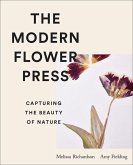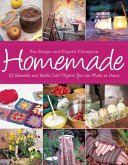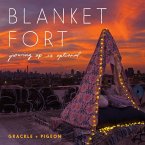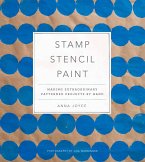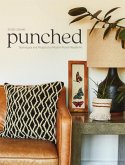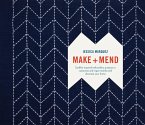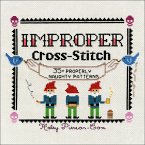Anna Hultin
The Stitched Landscape
An Embroidery Field Guide to the Textures, Colors, and Lines of the Natural World
Anna Hultin
The Stitched Landscape
An Embroidery Field Guide to the Textures, Colors, and Lines of the Natural World
- Gebundenes Buch
Observe and embroider the natural world with this inspiring guide to nature journaling with a needle and thread. Transform your appreciation of nature into unique works of art by stitching embroidered landscapes! Artist Anna Hultin’s step-by-step projects blend traditional embroidery skills with experimental techniques that draw inspiration from the lines, patterns, and textures of the natural world. Learn how to embroider flowers, plants, and trees using a few basic stitches, discover new techniques for a variety of non-traditional materials and methods like painting on fabric with…mehr
Andere Kunden interessierten sich auch für
![The Modern Flower Press The Modern Flower Press]() Amy FieldingThe Modern Flower Press30,99 €
Amy FieldingThe Modern Flower Press30,99 €![Homemade Homemade]() Ros BadgerHomemade20,99 €
Ros BadgerHomemade20,99 €![Blanket Fort Blanket Fort]() Grackle & PigeonBlanket Fort17,99 €
Grackle & PigeonBlanket Fort17,99 €![Stamp Stencil Paint Stamp Stencil Paint]() Anna JoyceStamp Stencil Paint24,99 €
Anna JoyceStamp Stencil Paint24,99 €![Punched: Techniques and Projects for Modern Punch Needle Art Punched: Techniques and Projects for Modern Punch Needle Art]() Stacie SchaatPunched: Techniques and Projects for Modern Punch Needle Art22,99 €
Stacie SchaatPunched: Techniques and Projects for Modern Punch Needle Art22,99 €![Make and Mend: Sashiko-Inspired Embroidery Projects to Customize and Repair Textiles and Decorate Your Home Make and Mend: Sashiko-Inspired Embroidery Projects to Customize and Repair Textiles and Decorate Your Home]() Jessica MarquezMake and Mend: Sashiko-Inspired Embroidery Projects to Customize and Repair Textiles and Decorate Your Home17,99 €
Jessica MarquezMake and Mend: Sashiko-Inspired Embroidery Projects to Customize and Repair Textiles and Decorate Your Home17,99 €![Improper Cross-Stitch Improper Cross-Stitch]() Haley Pierson-CoxImproper Cross-Stitch19,99 €
Haley Pierson-CoxImproper Cross-Stitch19,99 €-
-
-
Observe and embroider the natural world with this inspiring guide to nature journaling with a needle and thread. Transform your appreciation of nature into unique works of art by stitching embroidered landscapes! Artist Anna Hultin’s step-by-step projects blend traditional embroidery skills with experimental techniques that draw inspiration from the lines, patterns, and textures of the natural world. Learn how to embroider flowers, plants, and trees using a few basic stitches, discover new techniques for a variety of non-traditional materials and methods like painting on fabric with watercolors, collaging with fabrics to create depth, and stitching with raw wool, and learn how to compose these elements into an original scene based on your own nature observations.
Hinweis: Dieser Artikel kann nur an eine deutsche Lieferadresse ausgeliefert werden.
Hinweis: Dieser Artikel kann nur an eine deutsche Lieferadresse ausgeliefert werden.
Produktdetails
- Produktdetails
- Verlag: Storey Publishing
- Seitenzahl: 212
- Erscheinungstermin: 7. Oktober 2025
- Englisch
- Abmessung: 203mm x 203mm x 16mm
- ISBN-13: 9781635868456
- ISBN-10: 1635868459
- Artikelnr.: 73375275
- Herstellerkennzeichnung
- Libri GmbH
- Europaallee 1
- 36244 Bad Hersfeld
- gpsr@libri.de
- Verlag: Storey Publishing
- Seitenzahl: 212
- Erscheinungstermin: 7. Oktober 2025
- Englisch
- Abmessung: 203mm x 203mm x 16mm
- ISBN-13: 9781635868456
- ISBN-10: 1635868459
- Artikelnr.: 73375275
- Herstellerkennzeichnung
- Libri GmbH
- Europaallee 1
- 36244 Bad Hersfeld
- gpsr@libri.de
Anna Hultin is the artist and educator behind Olander CO Embroidery. Hultin uses needle and thread to create contemporary embroideries that explore the often overlooked beauty of the subtle textures and colors of the Colorado landscape. She lives with her family in Loveland, Colorado.
Table of Contents
Author's Preface
Introduction
● How to use this book :
○ Readers will be able to create a one of a kind landscape embroidery
inspired by their own observations
○ This book is written in the same way that I developed my embroidery:
starting small and working towards a larger landscape. Within these pages
we will work like an artist, developing our foreground, middleground, and
background. We begin with focusing on stitching one plant at a time while
learning embroidery basics. Through the process our embroidery skills will
grow, and we will experiment with new processes and materials. Eventually
we will be able to stitch an entire landscape with multiple plants,
textures, colors, and embroidery techniques.
● Studio Practice
○ Describe the ebb and flow of working in my studio, to working on my
couch, to working out on the land incorporating the idea of grounding
within my work
○ Goal of creating a landscape that is both abstract and still grounded in
reality
Chapter 1: Materials
● Fabric
● Needles
● Felt
● Hoops
● Thread
● Scissors/snips
● Water soluble markers
● Watercolor and gouache
● Brushes
● Roving
● Tulle
● Sketchbooks
● Material storage and set up
Chapter 2: Getting Started
● Getting set up to stitch
○ Hooping your fabric
○ Threading your needle
○ Drawing on the fabric
○ Choosing your color palette
● Basic embroidery stitches
○ Backstitch
○ Satin stitch
○ French knot
Chapter 3: Embroidering single flowers, plants, trees (Creating a
Foreground)
● How to stitch the parts of flowers, plants, trees, grasses, textures,
etc.
○ actual patterns/tutorials
○ a guide to create your own design through observing
■ ie: a satin stitch is used for petals, french knot for the stamen in most
flowers
○ Explanation that these elements are used to create movement in the
composition when used in a larger landscape context
● Land and Studio Connection ○ At home
■ Had my first baby. Wanted to step away from the gallery world and focus
on a simple, age old, craft
○ In the Studio
■ Early days of studio practice. Needed to meditate on a single plant or
tree while keeping my hands busy/mind still
○ On the Land
■ In the summer the garden is overflowing with flowers, colors, plants,
textures. It's almost too much to take in all at once so instead, let’s sit
down and study one plant at a time.
Chapter 4: Creating a Ground (Creating a Middleground)
● Techniques that create a ground for your plants
○ Watercolor
How to paint on fabric
Stitching on top of watercolor
○ stitching grass
■ “messy” satin stitch
■ choosing colors to create depth
○ Wool roving
■ a grass “shortcut”
■ attaching roving to fabric with thread Land and Studio Connection
○ At home
Learning about plant interactions in the garden
As my family grew, so did the complexity of my studio practice.
○ In the Studio
■ As skills grew I was able to stitch plant families and begin
experimenting
with new materials (watercolor)
○ On the Land
■ In the fall we start to notice plant relationships. We see one plant
start to die while another is still producing fruit. It is a time of
fluctuation. In this chapter we will focus on the relationship between
different plants. In our embroidery we will introduce a new medium:
watercolor and learn how thread and fabric interact with watercolor while
we start to embrace the relationships of plant families.
●
Chapter 5: Finding Composition in the Landscape (Creating a Background)
● Getting set up for sketching
○ Supplies you’ll need
○ How and where to sketch
● Finding line and texture
○ Photos of the landscape alongside my own sketches to show how I pick out
line and texture in a landscape.
○ Describing how to find these elements in any landscape
● Building a composition
○ Use photos with my sketches overlaid on them to show how I build a
composition by looking at a landscape
● Embroidering the Land
○ Examples of my finished work
○ Examples of other artists
● Techniques
○ Collaging with fabric
○ Creating a horizon line
○ Tulle overlay
● Land
○ At Home
and Studio Connection
■ The cold days of winter. Learning patience and waiting and finding beauty
in the mundane.
○ In the Studio
■ The breakthrough piece
■ First time I stitched a landscape that felt like it had elements of
abstract line in it but was still realistic
■ How do you make a piece that is both abstract and still grounded in
reality?
○ On the Land
■ Winter is a time of bareness. The bones of the landscape are visible, and
it is the best time to learn how to see composition within the landscape.
In this chapter we will start to find lines, textures and colors in a
landscape and learn how to build a composition. You can find these bones
through the foliage, but looking at your landscape in the winter will help
train your eye to find compositional elements quickly
Chapter 6: Creating an Abstract Landscape
● Creating your own composition
○ Creating a sketch and transferring it to fabric
○ basic composition templates
○ how to build a composition with a background, middle ground and
foreground
■ I start by creating a background and middle ground with the techniques
we’ve already laid out. From there I use the smaller plants we explored in
our foreground chapter to create movement within the piece.
● Techniques
○ Dripping effect
○ combining techniques
■ ie: how to use wool roving with watercolor or combining tulle overlay
with fabric collage
○ Backing your hoop
● Land and Studio Connection
○ At Home
■ Life is full, abundant, and when we find a rhythm it is magic.
○ In the Studio
■ Learning how to create pieces with plants/textures/lines harmonizing with
one another
○ On the Land
■ Spring is a time of fullness. The winter is melting away and the long
wait for new life is over. What better time than this is there to stop and
contemplate the landscape as a whole. In this section we will bring
together all of the things we have learned to compose an abstract
landscape.
Author's Preface
Introduction
● How to use this book :
○ Readers will be able to create a one of a kind landscape embroidery
inspired by their own observations
○ This book is written in the same way that I developed my embroidery:
starting small and working towards a larger landscape. Within these pages
we will work like an artist, developing our foreground, middleground, and
background. We begin with focusing on stitching one plant at a time while
learning embroidery basics. Through the process our embroidery skills will
grow, and we will experiment with new processes and materials. Eventually
we will be able to stitch an entire landscape with multiple plants,
textures, colors, and embroidery techniques.
● Studio Practice
○ Describe the ebb and flow of working in my studio, to working on my
couch, to working out on the land incorporating the idea of grounding
within my work
○ Goal of creating a landscape that is both abstract and still grounded in
reality
Chapter 1: Materials
● Fabric
● Needles
● Felt
● Hoops
● Thread
● Scissors/snips
● Water soluble markers
● Watercolor and gouache
● Brushes
● Roving
● Tulle
● Sketchbooks
● Material storage and set up
Chapter 2: Getting Started
● Getting set up to stitch
○ Hooping your fabric
○ Threading your needle
○ Drawing on the fabric
○ Choosing your color palette
● Basic embroidery stitches
○ Backstitch
○ Satin stitch
○ French knot
Chapter 3: Embroidering single flowers, plants, trees (Creating a
Foreground)
● How to stitch the parts of flowers, plants, trees, grasses, textures,
etc.
○ actual patterns/tutorials
○ a guide to create your own design through observing
■ ie: a satin stitch is used for petals, french knot for the stamen in most
flowers
○ Explanation that these elements are used to create movement in the
composition when used in a larger landscape context
● Land and Studio Connection ○ At home
■ Had my first baby. Wanted to step away from the gallery world and focus
on a simple, age old, craft
○ In the Studio
■ Early days of studio practice. Needed to meditate on a single plant or
tree while keeping my hands busy/mind still
○ On the Land
■ In the summer the garden is overflowing with flowers, colors, plants,
textures. It's almost too much to take in all at once so instead, let’s sit
down and study one plant at a time.
Chapter 4: Creating a Ground (Creating a Middleground)
● Techniques that create a ground for your plants
○ Watercolor
How to paint on fabric
Stitching on top of watercolor
○ stitching grass
■ “messy” satin stitch
■ choosing colors to create depth
○ Wool roving
■ a grass “shortcut”
■ attaching roving to fabric with thread Land and Studio Connection
○ At home
Learning about plant interactions in the garden
As my family grew, so did the complexity of my studio practice.
○ In the Studio
■ As skills grew I was able to stitch plant families and begin
experimenting
with new materials (watercolor)
○ On the Land
■ In the fall we start to notice plant relationships. We see one plant
start to die while another is still producing fruit. It is a time of
fluctuation. In this chapter we will focus on the relationship between
different plants. In our embroidery we will introduce a new medium:
watercolor and learn how thread and fabric interact with watercolor while
we start to embrace the relationships of plant families.
●
Chapter 5: Finding Composition in the Landscape (Creating a Background)
● Getting set up for sketching
○ Supplies you’ll need
○ How and where to sketch
● Finding line and texture
○ Photos of the landscape alongside my own sketches to show how I pick out
line and texture in a landscape.
○ Describing how to find these elements in any landscape
● Building a composition
○ Use photos with my sketches overlaid on them to show how I build a
composition by looking at a landscape
● Embroidering the Land
○ Examples of my finished work
○ Examples of other artists
● Techniques
○ Collaging with fabric
○ Creating a horizon line
○ Tulle overlay
● Land
○ At Home
and Studio Connection
■ The cold days of winter. Learning patience and waiting and finding beauty
in the mundane.
○ In the Studio
■ The breakthrough piece
■ First time I stitched a landscape that felt like it had elements of
abstract line in it but was still realistic
■ How do you make a piece that is both abstract and still grounded in
reality?
○ On the Land
■ Winter is a time of bareness. The bones of the landscape are visible, and
it is the best time to learn how to see composition within the landscape.
In this chapter we will start to find lines, textures and colors in a
landscape and learn how to build a composition. You can find these bones
through the foliage, but looking at your landscape in the winter will help
train your eye to find compositional elements quickly
Chapter 6: Creating an Abstract Landscape
● Creating your own composition
○ Creating a sketch and transferring it to fabric
○ basic composition templates
○ how to build a composition with a background, middle ground and
foreground
■ I start by creating a background and middle ground with the techniques
we’ve already laid out. From there I use the smaller plants we explored in
our foreground chapter to create movement within the piece.
● Techniques
○ Dripping effect
○ combining techniques
■ ie: how to use wool roving with watercolor or combining tulle overlay
with fabric collage
○ Backing your hoop
● Land and Studio Connection
○ At Home
■ Life is full, abundant, and when we find a rhythm it is magic.
○ In the Studio
■ Learning how to create pieces with plants/textures/lines harmonizing with
one another
○ On the Land
■ Spring is a time of fullness. The winter is melting away and the long
wait for new life is over. What better time than this is there to stop and
contemplate the landscape as a whole. In this section we will bring
together all of the things we have learned to compose an abstract
landscape.
Table of Contents
Author's Preface
Introduction
● How to use this book :
○ Readers will be able to create a one of a kind landscape embroidery
inspired by their own observations
○ This book is written in the same way that I developed my embroidery:
starting small and working towards a larger landscape. Within these pages
we will work like an artist, developing our foreground, middleground, and
background. We begin with focusing on stitching one plant at a time while
learning embroidery basics. Through the process our embroidery skills will
grow, and we will experiment with new processes and materials. Eventually
we will be able to stitch an entire landscape with multiple plants,
textures, colors, and embroidery techniques.
● Studio Practice
○ Describe the ebb and flow of working in my studio, to working on my
couch, to working out on the land incorporating the idea of grounding
within my work
○ Goal of creating a landscape that is both abstract and still grounded in
reality
Chapter 1: Materials
● Fabric
● Needles
● Felt
● Hoops
● Thread
● Scissors/snips
● Water soluble markers
● Watercolor and gouache
● Brushes
● Roving
● Tulle
● Sketchbooks
● Material storage and set up
Chapter 2: Getting Started
● Getting set up to stitch
○ Hooping your fabric
○ Threading your needle
○ Drawing on the fabric
○ Choosing your color palette
● Basic embroidery stitches
○ Backstitch
○ Satin stitch
○ French knot
Chapter 3: Embroidering single flowers, plants, trees (Creating a
Foreground)
● How to stitch the parts of flowers, plants, trees, grasses, textures,
etc.
○ actual patterns/tutorials
○ a guide to create your own design through observing
■ ie: a satin stitch is used for petals, french knot for the stamen in most
flowers
○ Explanation that these elements are used to create movement in the
composition when used in a larger landscape context
● Land and Studio Connection ○ At home
■ Had my first baby. Wanted to step away from the gallery world and focus
on a simple, age old, craft
○ In the Studio
■ Early days of studio practice. Needed to meditate on a single plant or
tree while keeping my hands busy/mind still
○ On the Land
■ In the summer the garden is overflowing with flowers, colors, plants,
textures. It's almost too much to take in all at once so instead, let’s sit
down and study one plant at a time.
Chapter 4: Creating a Ground (Creating a Middleground)
● Techniques that create a ground for your plants
○ Watercolor
How to paint on fabric
Stitching on top of watercolor
○ stitching grass
■ “messy” satin stitch
■ choosing colors to create depth
○ Wool roving
■ a grass “shortcut”
■ attaching roving to fabric with thread Land and Studio Connection
○ At home
Learning about plant interactions in the garden
As my family grew, so did the complexity of my studio practice.
○ In the Studio
■ As skills grew I was able to stitch plant families and begin
experimenting
with new materials (watercolor)
○ On the Land
■ In the fall we start to notice plant relationships. We see one plant
start to die while another is still producing fruit. It is a time of
fluctuation. In this chapter we will focus on the relationship between
different plants. In our embroidery we will introduce a new medium:
watercolor and learn how thread and fabric interact with watercolor while
we start to embrace the relationships of plant families.
●
Chapter 5: Finding Composition in the Landscape (Creating a Background)
● Getting set up for sketching
○ Supplies you’ll need
○ How and where to sketch
● Finding line and texture
○ Photos of the landscape alongside my own sketches to show how I pick out
line and texture in a landscape.
○ Describing how to find these elements in any landscape
● Building a composition
○ Use photos with my sketches overlaid on them to show how I build a
composition by looking at a landscape
● Embroidering the Land
○ Examples of my finished work
○ Examples of other artists
● Techniques
○ Collaging with fabric
○ Creating a horizon line
○ Tulle overlay
● Land
○ At Home
and Studio Connection
■ The cold days of winter. Learning patience and waiting and finding beauty
in the mundane.
○ In the Studio
■ The breakthrough piece
■ First time I stitched a landscape that felt like it had elements of
abstract line in it but was still realistic
■ How do you make a piece that is both abstract and still grounded in
reality?
○ On the Land
■ Winter is a time of bareness. The bones of the landscape are visible, and
it is the best time to learn how to see composition within the landscape.
In this chapter we will start to find lines, textures and colors in a
landscape and learn how to build a composition. You can find these bones
through the foliage, but looking at your landscape in the winter will help
train your eye to find compositional elements quickly
Chapter 6: Creating an Abstract Landscape
● Creating your own composition
○ Creating a sketch and transferring it to fabric
○ basic composition templates
○ how to build a composition with a background, middle ground and
foreground
■ I start by creating a background and middle ground with the techniques
we’ve already laid out. From there I use the smaller plants we explored in
our foreground chapter to create movement within the piece.
● Techniques
○ Dripping effect
○ combining techniques
■ ie: how to use wool roving with watercolor or combining tulle overlay
with fabric collage
○ Backing your hoop
● Land and Studio Connection
○ At Home
■ Life is full, abundant, and when we find a rhythm it is magic.
○ In the Studio
■ Learning how to create pieces with plants/textures/lines harmonizing with
one another
○ On the Land
■ Spring is a time of fullness. The winter is melting away and the long
wait for new life is over. What better time than this is there to stop and
contemplate the landscape as a whole. In this section we will bring
together all of the things we have learned to compose an abstract
landscape.
Author's Preface
Introduction
● How to use this book :
○ Readers will be able to create a one of a kind landscape embroidery
inspired by their own observations
○ This book is written in the same way that I developed my embroidery:
starting small and working towards a larger landscape. Within these pages
we will work like an artist, developing our foreground, middleground, and
background. We begin with focusing on stitching one plant at a time while
learning embroidery basics. Through the process our embroidery skills will
grow, and we will experiment with new processes and materials. Eventually
we will be able to stitch an entire landscape with multiple plants,
textures, colors, and embroidery techniques.
● Studio Practice
○ Describe the ebb and flow of working in my studio, to working on my
couch, to working out on the land incorporating the idea of grounding
within my work
○ Goal of creating a landscape that is both abstract and still grounded in
reality
Chapter 1: Materials
● Fabric
● Needles
● Felt
● Hoops
● Thread
● Scissors/snips
● Water soluble markers
● Watercolor and gouache
● Brushes
● Roving
● Tulle
● Sketchbooks
● Material storage and set up
Chapter 2: Getting Started
● Getting set up to stitch
○ Hooping your fabric
○ Threading your needle
○ Drawing on the fabric
○ Choosing your color palette
● Basic embroidery stitches
○ Backstitch
○ Satin stitch
○ French knot
Chapter 3: Embroidering single flowers, plants, trees (Creating a
Foreground)
● How to stitch the parts of flowers, plants, trees, grasses, textures,
etc.
○ actual patterns/tutorials
○ a guide to create your own design through observing
■ ie: a satin stitch is used for petals, french knot for the stamen in most
flowers
○ Explanation that these elements are used to create movement in the
composition when used in a larger landscape context
● Land and Studio Connection ○ At home
■ Had my first baby. Wanted to step away from the gallery world and focus
on a simple, age old, craft
○ In the Studio
■ Early days of studio practice. Needed to meditate on a single plant or
tree while keeping my hands busy/mind still
○ On the Land
■ In the summer the garden is overflowing with flowers, colors, plants,
textures. It's almost too much to take in all at once so instead, let’s sit
down and study one plant at a time.
Chapter 4: Creating a Ground (Creating a Middleground)
● Techniques that create a ground for your plants
○ Watercolor
How to paint on fabric
Stitching on top of watercolor
○ stitching grass
■ “messy” satin stitch
■ choosing colors to create depth
○ Wool roving
■ a grass “shortcut”
■ attaching roving to fabric with thread Land and Studio Connection
○ At home
Learning about plant interactions in the garden
As my family grew, so did the complexity of my studio practice.
○ In the Studio
■ As skills grew I was able to stitch plant families and begin
experimenting
with new materials (watercolor)
○ On the Land
■ In the fall we start to notice plant relationships. We see one plant
start to die while another is still producing fruit. It is a time of
fluctuation. In this chapter we will focus on the relationship between
different plants. In our embroidery we will introduce a new medium:
watercolor and learn how thread and fabric interact with watercolor while
we start to embrace the relationships of plant families.
●
Chapter 5: Finding Composition in the Landscape (Creating a Background)
● Getting set up for sketching
○ Supplies you’ll need
○ How and where to sketch
● Finding line and texture
○ Photos of the landscape alongside my own sketches to show how I pick out
line and texture in a landscape.
○ Describing how to find these elements in any landscape
● Building a composition
○ Use photos with my sketches overlaid on them to show how I build a
composition by looking at a landscape
● Embroidering the Land
○ Examples of my finished work
○ Examples of other artists
● Techniques
○ Collaging with fabric
○ Creating a horizon line
○ Tulle overlay
● Land
○ At Home
and Studio Connection
■ The cold days of winter. Learning patience and waiting and finding beauty
in the mundane.
○ In the Studio
■ The breakthrough piece
■ First time I stitched a landscape that felt like it had elements of
abstract line in it but was still realistic
■ How do you make a piece that is both abstract and still grounded in
reality?
○ On the Land
■ Winter is a time of bareness. The bones of the landscape are visible, and
it is the best time to learn how to see composition within the landscape.
In this chapter we will start to find lines, textures and colors in a
landscape and learn how to build a composition. You can find these bones
through the foliage, but looking at your landscape in the winter will help
train your eye to find compositional elements quickly
Chapter 6: Creating an Abstract Landscape
● Creating your own composition
○ Creating a sketch and transferring it to fabric
○ basic composition templates
○ how to build a composition with a background, middle ground and
foreground
■ I start by creating a background and middle ground with the techniques
we’ve already laid out. From there I use the smaller plants we explored in
our foreground chapter to create movement within the piece.
● Techniques
○ Dripping effect
○ combining techniques
■ ie: how to use wool roving with watercolor or combining tulle overlay
with fabric collage
○ Backing your hoop
● Land and Studio Connection
○ At Home
■ Life is full, abundant, and when we find a rhythm it is magic.
○ In the Studio
■ Learning how to create pieces with plants/textures/lines harmonizing with
one another
○ On the Land
■ Spring is a time of fullness. The winter is melting away and the long
wait for new life is over. What better time than this is there to stop and
contemplate the landscape as a whole. In this section we will bring
together all of the things we have learned to compose an abstract
landscape.


